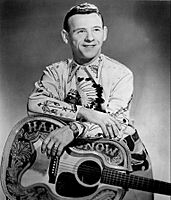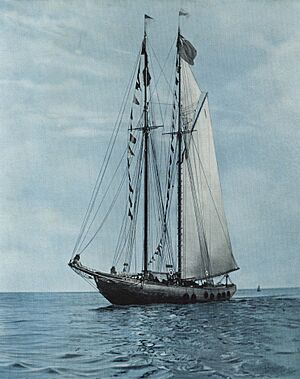Hank Snow facts for kids
Quick facts for kids
Hank Snow
|
|
|---|---|

Snow in 1970
|
|
| Background information | |
| Birth name | Clarence Eugene Snow |
| Also known as | Hank, The Yodeling Ranger Hank Snow, The Singing Ranger |
| Born | May 9, 1914 Brooklyn, Nova Scotia, Canada |
| Died | December 20, 1999 (aged 85) Madison, Tennessee, U.S. |
| Genres | Country |
| Occupation(s) |
|
| Instruments | Vocals, guitar |
| Years active | 1936–1996 |
| Labels | RCA Victor |
| Associated acts | Carl Smith, Anita Carter, Chet Atkins, Stephen H. Sholes, Ernest Tubb, Eddy Arnold, Hank Williams |
Clarence Eugene "Hank" Snow (May 9, 1914 – December 20, 1999) was a famous Canadian-American country music guitarist, singer, and songwriter. He was active for over 50 years, starting in the 1950s.
Hank Snow recorded 140 albums in his career. He had more than 85 hit songs on the Billboard country charts. These hits came out between 1950 and 1980. Some of his number-one songs include "I'm Moving On" and "The Golden Rocket". He also sang popular versions of songs like "I Don't Hurt Anymore" and "I've Been Everywhere".
As a songwriter, Hank Snow wrote about many things. He sang about the joy of freedom and travel. He also wrote about the pain of difficult love. His songs often came from his own life experiences. His music was inspired by his early life in Nova Scotia. He grew up in extreme poverty and worked hard during the Great Depression. His mother always supported him. She encouraged him to become an entertainer, just like his hero, Jimmie Rodgers.
Snow won many music awards. He is a member of the Country Music Hall of Fame. He is also in the Canadian Country Music Hall of Fame and the Canadian Music Hall of Fame. The Hank Snow Museum in Liverpool, Nova Scotia celebrates his amazing life and music.
Contents
Hank Snow's Early Life
Hank Snow was born on May 9, 1914. His full name was Clarence Eugene Snow. He was born in a small town called Brooklyn in Nova Scotia, Canada. He was one of six children. His parents, George and Maude, worked hard to support their family. His father worked in sawmills, and his mother cleaned houses.
Both of Hank's parents loved music. His mother was a great singer. She played piano for silent movies. She also performed in shows sometimes. She loved her own pump organ.
When Hank was eight, his parents separated. He went to live with his grandmother. Later, he was able to live with his mother again.
Hank's Musical Start
Hank's mother bought a Hawaiian steel guitar. It came with free lessons and records. At first, she didn't want Hank to touch it. But when she let him play, she was amazed. He quickly learned to play well. Soon, he was asked to play for neighbors.
Life at Sea and Music
In 1926, Hank found work on a fishing schooner. He worked as a cabin boy. He didn't get paid wages. But he could sell cod tongues and fish he caught. After one trip, he earned about $58. He felt rich! He used some money to buy a guitar and a chord book.
While at sea, Hank listened to radio shows. He heard country artists like Vernon Dalhart. He loved songs like "The Prisoner's Song". He tried to sing them exactly like the artists. He entertained his crewmates by singing and dancing. He also played his mouth organ.
Hank's fishing trips were good until 1930. His schooner got caught in a terrible storm. It was blown towards Sable Island. This island was known as the "Graveyard of the Atlantic" because many ships wrecked there. Luckily, the wind changed, and they were saved. After this scary event, Hank decided he would never go to sea again.
Life After Sailing
After leaving the sea, Hank lived with his mother and stepfather. He didn't have a steady job. He sold fish door-to-door. He also took people and their luggage by horse and buggy. He unloaded salt and coal ships. He even cut wood with his father one winter.
On September 2, 1935, Hank married Minnie Blanche Aalders. She worked in a chocolate factory. They soon had their only child, Jimmie Rodgers Snow.
Hank Snow's Music Career
Hank saw a guitar in a catalogue for $12.95. He sold his old guitar for five dollars. He needed more money for the new one. A store owner hired him to paint stripes on his new car. Hank earned two dollars per wheel. With the new guitar, Hank practiced playing like Jimmie Rodgers. He also sang and played in a fishhouse.
Soon, Hank was asked to perform in a show. He played a song called "I Went to See My Gal Last Night." He said his first show was a big success. He even got a standing ovation!
In 1933, Hank wrote to a radio station in Halifax, CHNS. He asked for an audition. They said no at first, but he didn't give up. Later that year, he got an audition and was hired. He had a Saturday evening show called Clarence Snow and his Guitar. After a few months, he called himself "The Cowboy Blue Yodeler." This was a tribute to his hero, Jimmie Rodgers.
Hank wasn't paid for his radio show at first. But he earned money by playing in clubs. He also played in theaters before movies. He later got a paid show on CHNS. The station's engineer suggested he change his name to Hank. He became "Hank, The Yodeling Ranger." He also appeared on the CBC radio.
Canadian Success
On October 29, 1936, Hank auditioned for RCA Victor in Montreal, Quebec. He got a recording contract! His first record had "The Prisoned Cowboy" and "Lonesome Blue Yodel." Hank stayed with RCA Victor his whole career. He recorded for them until 1981.
A weekly CBC radio show made him famous across Canada. He toured Canada until the late 1940s. Then, American country music stations started playing his songs.
Moving to Nashville
Hank Snow moved to Nashville, Tennessee, in 1949. He made his first American records for RCA Victor. His first US song, "Marriage Vow," became a top ten hit in 1949. But he became truly famous in the United States when he played at the Grand Ole Opry in 1950.
His next song, "I'm Moving On," was released in early 1950. It was his first number-one hit. "I'm Moving On" stayed at the top for 21 weeks. This set a record for the longest time at number one! That same year, "The Golden Rocket" and "The Rhumba Boogie" also hit number one.
Another one of his most famous songs was "I've Been Everywhere." In this song, he pretended to be a hitchhiker. He bragged about all the towns he had visited. The song was first written in Australia. Hank changed it to include North American towns. Singing all the city names quickly is a challenge for any singer!
While performing, Hank worked with a young Hank Williams. In 1953, Hank's son, Jimmie Rodgers Snow, also signed with RCA Victor. He recorded songs with his father.
Rainbow Ranch Home
After his success, Hank Snow bought a ranch home. It was in Madison, Tennessee. He named it 'Rainbow Ranch'. This was the same name as his band, the "Rainbow Ranch Boys." Today, his family has restored the home. It was added to the National Register of Historic Places listings in Davidson County, Tennessee in 2018.
Helping Elvis Presley
Hank Snow was a regular performer at the Grand Ole Opry. In 1954, he helped a young Elvis Presley get on stage. Snow used Presley as his opening act. He also introduced Elvis to Colonel Tom Parker. In 1955, Snow and Parker formed a management team. They signed a contract with Elvis. But soon, Parker took full control of Elvis's career.
Later Career and Achievements
Hank Snow performed for six decades. He wore fancy, colorful suits with sequins. He sold over 80 million albums! He became an American citizen in 1958. But he still kept his friendships in Canada. He also sang about Canada in his music, like in his 1968 album My Nova Scotia Home.
Even though he didn't have much schooling, Hank was a talented songwriter. In 1978, he was chosen for the Nashville Songwriters Hall of Fame. In Canada, he was named the top country music performer ten times. In 1979, he was inducted into the Country Music Hall of Fame. He also joined the Canadian Music Hall of Fame and the Nova Scotia Music Hall of Fame. In 1985, he was inducted into the Canadian Country Music Hall of Fame.
His autobiography, The Hank Snow Story, was published in 1994. Later, The Hank Snow Country Music Centre opened near his old home in Liverpool, Nova Scotia. Hank Snow also helped children who had difficult times growing up.
Illness and Death
In 1996, Hank Snow had breathing problems. This made him stop performing. He passed away three years later, on December 20, 1999. He was 85 years old. He died at his Rainbow Ranch in Madison, Tennessee. He was buried in Nashville's Spring Hill Cemetery. His wife, Minnie, died in 2003.
Hank Snow's Legacy
Many famous artists have sung Hank Snow's songs. These include Elvis Presley, The Rolling Stones, Ray Charles, Johnny Cash, and Emmylou Harris.
One of his last big hits was "Hello Love". This song was sung by Garrison Keillor to start his radio show, Prairie Home Companion. "Hello Love" became Hank Snow's seventh number 1 hit in April 1974. He was almost 60 years old. This made him the oldest country artist to have a number one song at that time. He held this record for over 26 years!
Hank Snow has also been featured in movies. In the 1975 film Nashville, a character was based on him. Australian actor David Wenham played Hank Snow in the 2022 movie Elvis.
Hank Snow is mentioned in the song "The Wino and I Know" by Jimmy Buffett. A fictional snow god in Michigan, Heikki Lunta, is named after Hank Snow. "Heikki Lunta" means "Hank Snow" in Finnish.
Discography
See also
- Music of Canada
- List of best-selling music artists



